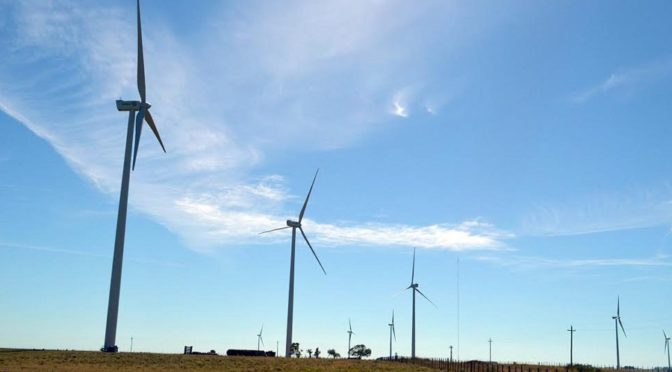The projects of recent years are still under development, but with the increase in the cost of capital, the call for new tenders is expected to slow down; The lack of transmission lines is another bottleneck.

Wind power parks in Trelew.
The renewable energy sector was one of the fastest growing in the last four years, but – like the rest of the economy – its future is unknown according to analysts, since it is a capital and moment intensive industry The financing is closed for Argentina.
Ads by
Law 27,191 of renewable energies, approved unanimously in 2015, establishes that for this year 12% of the total energy matrix must come from green sources. The goal is to reach 20% by 2025. There are currently 49 projects in operation that represent an average of 6% injected power, according to the Undersecretary of Renewables. In addition, 102 more projects are under construction, which are close to being operational and represent an additional 9% of green energy, which would give a total of 15% in the coming months. Four years ago, when the law was passed, renewables barely accounted for 0.8% of the total.
“It is difficult to know what will happen to the sector in the future because it depends on many externalities,” said Santiago Alsina, managing director of Lazard, who listed four examples: “Knowing what will be the demand and supply of electricity next year, which depend of the projected GDP, and today it is difficult to estimate; that there are clear rules of the game, but it is still unknown to know what the next government’s policies will be; to lower the country risk, since it is a capital-intensive industry, and that more transmission lines be built, which today represent a bottleneck. “
On the subject of financing, Alsina explained that renewable projects have a “very fine” dollar return rate of around 13% per year, while at the same time, companies are financed at 8%. In countries like Chile, Mexico, Peru and Colombia, capital is achieved at a rate of 4%, which allows renewable energy projects to be cheaper.
Regarding projections of future demand, the Secretary of Energy, Gustavo Lopetegui, said that today the market is balanced, since in recent years 9.5 GW of power energy (renewable and thermal) have been added to the system and, at the same time, consumption fell due to the increase in rates and the recession, which impacted on industrial demand.
“We are comfortable in terms of generation, we have no hurry to continue bidding. The technology [of wind generators and solar panels] advances every semester, and in this industry the cost of capital is everything. We are not at the most appropriate time to tender something, “he admitted after STEP.
In relation to the transport of electric energy, several Renew and Mater programs (private contracting mechanism) have been awarded in recent years, but no progress has been made in the construction of new high-voltage power lines. Last April, the Government called for a tender to build a line that connects the Río Diamante (Mendoza) transformer station with Charlone (Buenos Aires), but the award is delayed, with no prospect of progress in the short term. The same applies to the call for tender for the renew 4 program, which included investments in the transmission network as well.
If Mauricio Macri is re-elected, the Government is expected to continue with the development of the sector. In the event that the next president is Alberto Fernández, analysts also point out that there could be continuity, since the law was passed during the last year of Cristina Kirchner’s government. In both cases, however, it is necessary for the international market to reopen.
“The financing for these projects is very complex. It will be necessary to normalize the financial system to make the projects viable again and that renewal rounds can continue to be carried out to comply with the quotas of the law,” says Juan Cruz Azzarri, partner of Martínez de Martínez Sickle & Wheel. “It would also be necessary to make certain terms of contracts and obligations more flexible in relation to the times for commercial authorization or financial closure. Renew was a very well thought out program, but it was written in 2017, in a context in which the country had another access to the capital market, “he added.
In the same way, Diego García, a partner of Bain & Company, agreed that “there will be a bit more brake in the development of renewables.” “The biggest incentive to boost the sector were the objectives that we had established in the law, but with more financial stress, those goals go to the background. There is a lot of uncertainty and a lot of volatility and renewable energies require more certainty than the rest because they are more capital intensive, “he said.


